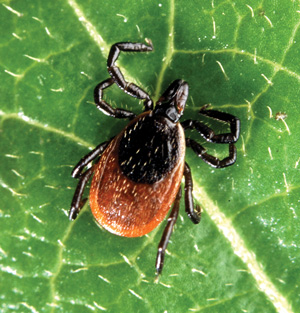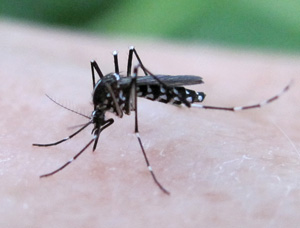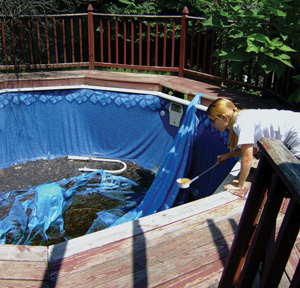These days, enjoying life outdoors is almost a hazard to your health. But Nature in the Skylands is not to be missed despite voracious female mosquitoes seeking blood for protein and fat for her eggs, or despite deer ticks or black flies, sometimes just out to taunt. So don’t be scared. Be aware! Arm yourself with knowledge. There are plenty of things you can do right in your own backyard to deter these tiny critters and still have fun outdoors.
The three counties with the highest rate of Lyme disease in the state are in Northwest New Jersey: Morris, Hunterdon and Sussex. Warren comes in sixth. Hunterdon County has been ranked among the top counties in the entire country for confirmed cases of Lyme disease. The deer tick, Ixodes scapularis, is responsible.
Dr. John Harrington, chiropractor/nutritionist at Sunrise Nutrition Center in Blairstown treats patients with Lyme disease, many of whom have not been properly diagnosed, or under-diagnosed, because it just doesn’t show up in tests. Clients experience the classic aches and fever, and even brain fog, vertigo and change in personality. Mood disorders have multiple causes, and sometimes it’s from Lyme disease, he says. “I’ll put them on various herbs and nutritional natural therapies to give the body immune support and the ability to detoxify and work on their diet. Many times, fueling the body gives it enough of a boost to fight bacteria on its own.” Harrington considers the whole of a person’s condition when diagnosing and treating.

Studies show that deer ticks harbor other disease-causing organisms, with names like Borrelia, Babesia, Anaplasma and Bartonella, found in the spinal fluid of patients with Lyme disease. Harrington usually sees people with Bartonella and Lyme together, sometimes with underlying heavy metal problems. (Chronic exposure to certain elements—like lead, cadmium, and mercury—has adverse metabolic effects.) Harrington offers treatment that complements their medical program. “I often treat Lyme patients for virus and microscopic parasites with herbal remedies and nutrition. Detox is so important with Lyme disease.”
Ticks also can transmit a parasite of red blood cells that causes Babesiosis, a disease that has symptoms similar to malaria, although its death rate is lower. In 2012, there were ninety-two cases in New Jersey. Symptoms disappear and reappear, but people with a sound immune system can fight it off. “Tests are better than they were but still not one hundred percent accurate. It has a spreading red rash in two-thirds of the cases, but tests may still read negative,” says Marc Slaff, Ph.D., Lecturer, Dept. of Entomology at Rutgers University. And last year, a Hunterdon County woman contracted a disease similar to Lyme, yet so rare that there is no name for it.
Powassan Virus is another tick-born disease new to New Jersey. Last year there were three cases in New York and one in Warren County, where a woman died. The deer tick and the locally rare groundhog tick, each with its own type of Powassan Virus, carry it, says Jennifer Gruener, Superintendant of Warren County Mosquito Control Commission. The mortality rate is 7-15%, and there is no drug treatment for Powassan Virus. “She was exposed to the tick in May, went to the hospital a week later with fever, headaches and vomiting, and died the next day.” The virus is so rare that the only place to test is the Center for Disease Control (CDC). Lab tests show it only takes fifteen minutes for an embedded tick to transmit Powassan Virus, and from two to forty-eight hours to transmit the Lyme spirochete (a type of bacteria), so prevention is key. Do tick checks first with your clothes on outside your home, then naked indoors.
If you spend time in open fields and shrubby areas where ticks are most prevalent, especially from early May through early July, be on high alert and take extra measures. At that time of year, Slaff advises using either Picaridin or DEET-based repellant with a 25-30% active ingredient on your clothes from the waist down to your shoes. The spray blocks the ticks’ radar and prevents them from finding a host. Avoid Permethrin, which is dangerously toxic to fish and cats and mildly toxic to humans. If you use it, do so only on clothes or shoes. At home, keep hiking clothes separate from others and toss them in the dryer for heat to kill any ticks. They survive the washer just like they’ll survive the snow!
There are over three thousand mosquito species in the world, with over sixty-three species in New Jersey and forty-four in Warren County. All are different from each other in behavior, appearance, habitat and where they get their blood meals. Some prefer people, some frogs or birds, others are generalists. Only the females bite in order to nourish their eggs.

Dengue Virus and Chikungunya Fever are two potential emerging infectious diseases transmitted by two related species: Aedes aegypti and Aedes albopictus, also known as the Asian tiger mosquito, the most recent arrival in New Jersey. Dengue Virus, which infects 400,000 people yearly in the tropics, is making its way to the U.S. via travelers to tropical destinations—or visitors from there—who bring the virus back, having been bitten by an infected mosquito. Once here, they get bitten by the Asian tiger, which becomes infected and transfers the virus to a new victim. In December 2013, Dengue Virus killed a Maryland man and infected a Long Island, New York, resident. Chikungunya Virus, transmitted the same way, can also spread by blood transfusions. Chikungunya is a painful, though not generally fatal, disease from South Africa that spread to the Caribbean with an outbreak of thousands of cases. Given the virus’s adaption to the Asian tiger mosquito, Slaff says, “I would not be surprised to see at least a few cases of this disease.”
Since the main perpetrator of Dengue Virus (A. aegypti), has not yet arrived here, and because the virus doesn’t live well in the Asian tiger mosquito, officials are not yet overly concerned. Nevertheless, it would be advisable to take measures to prevent potential contact with either Dengue or Chikungunya, both of which have no cure. The troublesome new resident Asian tiger has spread to twenty-six states since 1985. “In New Jersey we find it in small confined areas like Phillipsburg,” says Gruener, of the mosquito’s spread. “It overwinters as an egg. We hope the hard winter will kill the eggs.” It thrives in urban and suburban areas and mates aggressively, breeding in watery containers like birdbaths, tires, buckets and cans. It can even spend its entire life cycle in a bottle cap with just a few drips of water. That makes it particularly difficult to get rid of unless people remove these small breeding grounds from their property.
The universally common Aedes vegans, vector (transmitter) of dog heartworm and equine encephalitis, and other species, lay their eggs in places they know will eventually flood, like roadside ditches, rain puddles and vernal pools. These mosquitoes are a major nuisance when multiple generations hatch in big broods and attack after every major rainfall.
Culex mosquitoes prefer to suck the blood of birds, rather than people, but one species, Culex pipiensi, the common house mosquito, transmits West Nile Virus from birds to people. Because we humans are not the normal host of the mosquito or virus, our immune systems are not well prepared to deal with it. West Nile is a disease that threatens people over the age of people aged fifty. In 2013, 2,374 cases of West Nile Virus, including 114 deaths, were reported to the CDC nationwide. Twelve were in New Jersey, down from forty-eight in 2012, with two fatal, according to New Jersey State Department of Health. Morris County had one case last year. “There is West Nile Virus here but it’s more in south Jersey and in urban areas,” Slaff says. In urban areas, mosquitoes thrive in contaminated water in buckets, gutters, birdbaths, pools, and tires; wherever it can stagnate. “They live around conditions produced by humans, in heavily suburbanized and polluted areas. The higher the percentage of people, the higher percentage of food and water sources. The time of highest risk of disease to humans to be out is August through early September and six or seven weeks in spring.” West Nile is a type of encephalitis, the most common being Eastern Equine Encephalitis, also transmitted by mosquitoes. “It is dangerous, deadly and sporadic. The fact that you don’t see it often is a credit to Mosquito Control,” says Slaff. New Jersey’s active and dedicated mosquito control commissions monitor mosquito populations, track them and take preventive measures.
“The nastier the better,” says Gruener of containers where females lay 100-300 eggs and glue them together to form “rafts” about a quarter inch long. Mark Vlazny, biologist with Morris County Division of Mosquito Control, also finds them in underground areas of moisture including basements and sewers, for if the eggs dry, they die.
Slaff thinks the volume of snow this winter will produce different types of mosquitoes, especially along floodplain areas. Most are not disease vectors but come out in large numbers at the same time and cause a nuisance. Some species lay dormant and when conditions are right they hatch out all at once. “It is quite remarkable. It’s going to give Mosquito Control quite a busy spring.”

“We go through our routes, take water samples and find out how many larvae are there and decide whether we have to control them. We do if it’s a disease threat,” says Gruener. The Commission cleans clogged ditches so they flow again. Mosquito larvae live just beneath the surface of water and breathe through a “siphon.” If the water begins to flow or becomes disturbed, the siphon closes and they cannot breathe and then die. (Perhaps this is why ponds are aerated.) Larvae are filter feeders, so hang there and wave their built-in brushes on each side of their mouth to bring microscopic food into their mouth. Studies are being done to determine if they improve water quality. Everything is good for something, isn’t it?
Protect yourself! Use Picaridin, DEET-based repellents, or oil of lemon eucalyptus and destroy mosquito habitat in your yard so there is no stagnant water. Turn over buckets and wheelbarrows, cover trash cans, pick up debris, change bird bath water every three days, keep gutters clear and used tires dry.
Several products purport to repel or kill mosquitoes without the use of sprays, but don’t be fooled! “Scientific studies have repeatedly shown that electronic mosquito repellers do not prevent host seeking mosquitoes from biting. In most cases, the claims made by distributors border on fraud,” stated Wayne J. Crans, Professor Emeritus, Dept. of Entomology, Rutgers. Zappers are also a rip-off because biting insects make up less than one percent of the insects they kill, while the nightly tally of beneficial insects is higher. Zappers also kill harmless insects that would otherwise be food for wildlife. It has also been proven that genetically engineered Citrosa plants that emit a citronella aroma do not reduce mosquito bites. In studies, mosquitoes landed freely on its leaves. And if you’re thinking of housing insectivorous bats, mosquitoes make up a small amount of their diet.
Mosquito Control Commissions use various methods to kill mosquitoes. Warren County buys fathead minnows from bait shops and non-native mosquito fish, Gambusia affinis, grown by Charles O. Hayford State Fish Hatchery in Hackettstown with approval on a site-by-site basis. In containers with stagnant water, fathead minnows eat mosquito larvae and pupae before they fly away as adults. Commission employees empty abandoned swimming pools, tires and other debris and treat mosquito-breeding places. They research, test and educate residents and kids at school. In winter, they map out control routes of areas with transient water like river floodplains and retention and detention basins that get clogged up. The take home message is Don’t Get Bit!
There are thirty-eight species of black flies in New Jersey. They are particularly problematic in Hunterdon County due to an abundance of perfect habitat: the fast moving Delaware, Musconetcong and Lamington Rivers and the South Branch of the Raritan, and smaller creeks and streams. The first black flies to emerge in late March/early April overwinter as larvae in small creeks and streams. They come out all at once and bite, lay eggs and die. This nuisance species has just one brood a year but what a sight not to behold!
Summer black flies, which are smaller, overwinter as eggs in the larger rivers, then emerge by late April. The females will lay eight to ten broods, each with 300-1,000 eggs per brood, every season starting in May. They fly up to fifteen miles away from their breeding rivers.
“Black flies use sight to hone in, not by chemical,” says Tadhgh Rainey, Manager, Hunterdon County Division of Public Health Services. “They prefer to swarm around the head and then cue into carbon dioxide. Kids get more bites than adults. We’re probably not the preferred host.”
Because black flies are strong fliers, they must be controlled in the larval stage, before they have emerged from the water. The Pennsylvania Department of Environmental Protection takes care of the Delaware and Hunterdon protects parts of the South Branch. Rainey says it’s not uncommon to get calls from all over the state about black flies. “It’s a very interesting insect that not many people know.”
Gruener’s advice: “Take matters into your own hands to protect yourself. Take care of your own property and empty containers so they don’t add to the problem. Knowledge is power. The more you know the better off you are.”